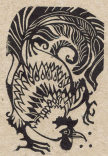
"my goodness - you do printing as well !"
Whilst at St. Albans School of Art I had the great good fortune to have the late John Brunsdon as my tutor for etching. Though printing wasn't the route I took in my career, it has always attracted and interested me.
I do not make many prints, but whatever print-medium I am using, I thoroughly enjoy trying to get the medium to fit into my own mildy 'different' way of looking at things, and of using the techniques.
Contact me via the link in the menu-bar above.
Scratching Cock - linocut
It was a small piece of lino that I came across in my drawer that I used to cut this cockerel. As I worked on it, I had in mind the Japanese netsuke carvings, where all the carving is contained within a small piece of ivory.
The cockerel is somewhat similar to one of my Llanfair neighbour's fine birds, which was still happily scratching in 1998 when I first sketched it.
Image 10.5 x 15.25 cm. Signed, unlimited edition. Hand made paper.
Peacock in the Rose Garden - linocut
The balustrades against the blue cedar immediately reminded me of a childhood storybook in which a white peacock magically stood out in the dusk.
I have placed the peacock in the Rose Garden in the National Trust House at Erddig, near Wrexham in North Wales. I love the shapes of the brick Dutch gable in the Victorian parterre.
Image 17.25 x 37 cm. Signed, unlimited edition. Hand made paper.
Lenhall Farm in lovely Kent
Etching. Edition of 50. Image size 22 by 30cm.
Enhanced after printing.
You may still be able to see it in photographic form here.
The hosts of the photo, Geograph, say that this is a - "four square kilned oast house - greenstage attached to kilns.
An Oast House is a building used to dry fresh hops before they are sent to the brewers, to be used for flavouring beer. A traditional Oast House consists of the 'oast' and the 'stowage'. The oast was a kiln, with a plenum chamber fired by charcoal at ground floor and the drying floor directly above. The steep pitched roof channelled the hot air through the hops to the top. The stowage, was the barn section, it had a cooling floor and press at first floor and storage area at ground floor."
Littlebourne Oast House, Kent
Etching. Edition of 50. Image size 22 by 30cm.
The print is hand-enhanced after printing.
You may know this building, now rather changed from its Oast House identity ... my etching was done a few years back, and seeks to capture its beauty as a long-standing agricultural landmark.
This link to a Francis Frith photograph (if the link is still live) shows the building long before it stopped being "agricultural".
In the memories that are appended to the photograph, Jenny Green writes - "I am the little girl with the blonde ringlets standing facing away from the river and I remember having that photograph taken with my sister Sadie the girl with the dark hair, who was 8 at the time and I was 6. It was taken in 1962."
Nigel Woodcock says - "My Late father John Laidler and his sister Anita Laidler are in this picture. They lived at the time in Nargate street, Brewery Cottages before moving to Garrington Farm. Wonderful memories my dad shared with me. Long summer days were spent a lot in the river, raft building - and as you can see, the rope swing, Very carefree and happy times. He remembered this picture being taken and also remembers Sadie being there."






